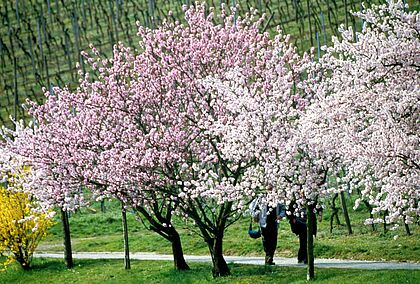Kastanienbusch
Berömda vingårdar

W�e�i�n�b�e�r�g�e� �i�n� �d�e�r� �P�f�a�l�z�,� � � �M�a�n�d�e�l�b�l�?�t�e���
Almonds in Spring, Chestnuts in Autumn - Namesakes of Sites and Festivals in the Pfalz
One of the years earliest wine festivals in Germany celebrates both wine and the blossoming of almond trees (FB gallery) a harbinger of spring and the start of a new growing season. The Mandelblütenfest takes place in March (date varies, depending on the outset of blossoming) in the Neustadt suburb of Gimmeldingen, midway along the Deutsche Weinstrasse (German Wine Road) that runs the length of the Pfalz. Find more wine festivals and -events in Germany.
Kastanien (chestnuts), known in local dialect as “Käschde” or “Käschte,” take center stage in the autumn, particularly at the Käschdefescht in early October in Annweiler, about 15 minutes’ drive west of the Südliche (southern) Weinstrasse.
Both nut trees are innate to the landscape of Germany’s second largest wine-growing region and numerous Pfälzer vineyards are named after almonds (14 sites) and chestnuts (2 sites), including this month’s famous site Kastanienbusch in Birkweiler.
Many a southern Pfälzer village name ends in “–weiler,” meaning hamlet. “Birk–” refers to the birch trees in the forests that top the vine-clad slopes adjacent to town. Birkweiler, first documented in 1285, is a picturesque little wine village full of old half-timbered and/or stone houses with massive courtyard portals, and streets canopied with vines and lined with flowerboxes. There are no fewer than 17 wine estates in this village of ca. 700 people. Its three vineyard sites – named after roses, almonds and chestnuts – comprise some 200 ha/495 acres. The annual wine festival takes place in the second half of July.
Kastanienbusch, recorded in 1803 as “Im Kästenbusch” and in 1836 as “Kästen-Busch,” is about 80 ha/nearly 200 acres in size. It has a south-southeastern exposure and lies in a natural hollow at the foot of Hohenberg hill – the peak of which is at least 550 meters/1,800 feet high – which helps protect the vineyard from cool westerly winds. Some 40% of the site is quite steep; 60% sloping. Vines are planted at an altitude from 160 to well over 300 meters/525 to 985 feet above sea level.
While the Haardt mountains (an extension of the French Vosges) extend well into the northern part of the Pfalz, shifting faults over the centuries resulted in hills and vales that are much more pronounced in the southern Pfalz – and led to very diverse soil conditions. In Kastanienbusch, soils include Rotliegendes (an iron-rich, red soil mixture of slaty clay and sandstone) – as found in the famous Nackenheim and Nierstein vineyards of the Rhine terrace in Rheinhessen; weathered colored sandstone; and sandy loam top soil above colored sandstone and colored marl/keuper. Many grape varieties are cultivated, but Rieslings and Pinots – Spätburgunder (Pinot Noir), Weissburgunder (Pinot Blanc) and Grauburgunder (Pinot Gris) – as well as the ancient white variety Silvaner (traditional in this site) are particularly prized. Spicy specialties, such as Gewürztraminer and Muskateller are also cultivated here.
Tips for Tourists:
- The Pfälzer Wald (Palatinate Forest) has an extraordinary network of marked paths for walking, hiking or cycling. The SÜW (Südliche Weinstrasse) shop at the regional tourist office in Landau has a great supply of detailed maps and brochures. An der Kreuzmühle 2. Closed Friday afternoons and weekends.
Within half an hour of Birkweiler:
- The small spa Bad Bergzabern. Don’t miss Café Herzog, home of Weinperlen, unusual wine-filled chocolates, and an ice cream version known as Weinperleneis. Closed Wednesday morning and Monday.
- Burg Trifels, a 12th-century Hohenstaufen castle perched on a sandstone bluff overlooking Annweiler, and nearby Museum unterm Trifels. Serenaden (concerts) in summer and a medieval Burgfest first weekend in August.
- Fabulous views from Burg Landeck (castle ruins dating from ca. 1200) near Klingenmünster.
- Speyer cathedral (1030), a UNESCO World Heritage site and remarkable example of Rhenish Romanesque architecture. Also in Speyer: Palatinate Historical Museum with the Wine Museum (and world’s oldest bottle of wine, from ca. AD 300), the Technology Museum, and the historical Jewish quarter.
- Holiday Park in Hassloch (east of the Weinstrasse, ca. 50-minute drive) – one of Europe’s largest amusement parks with fantastic rides and roller coaster.
- Wine, dine and overnight at Sonnenhof, Mühlweg 2, 76833 Siebeldingen, village next to Birkweiler. Restaurant closed Thursday. Beautiful terrace shaded by old chestnut trees.
- For gourmets: the upscale country inn Hotel-Restaurant Zur Krone, Hauptstrasse 62-64, 76863 Herxheim-Hayna (east of the Deutsche Weinstrasse). Zur Krone is the gourmet restaurant (closed Monday and Tuesday; no lunch); same team prepares food for the hotel’s more casual Pfälzer Stube (no lunch Tuesday).
- In downtown Landau, dine in a wine restaurant owned by five top southern Pfälzer estates: Fünf Bäuerlein (five farmers), Theaterstrasse 2. Closed Sunday; no lunch Monday; no dinner Saturday. No credit cards.
- In downtown Speyer, Backmulde, Karmeliterstrasse 11–13, serves excellent food and wine (closed Monday), or dine in the vaulted cellars of the old town hall, Ratskeller, on Maximilianstrasse12 (closed Monday, no dinner Sunday).
Many thanks to Weingut Dr. Wehrheim for supplying photos and confirming background information.
